So you’re looking to blow minds with your next guitar solo or craft a riff that will be the foundation of your band’s new hit? You’re probably searching for that secret weapon, a set of notes that just works in almost any musical situation.
Good news! That secret weapon exists, and it’s called the pentatonic scale. This five-note scale is incredibly versatile and used across countless genres, from rock and blues to country, pop, and beyond.
In this comprehensive guide, we’ll dive deep into the world of the pentatonic scale. We’ll explore what it is, how to play it all over the guitar fretboard using Pentatonic Scale Guitar Tabs, and how to unleash its power in your own playing. Get ready to unlock a universe of musical possibilities!
Understanding the Pentatonic Scale
Pentatonic Scale: The 5-Note Wonder
The word “pentatonic” itself gives you a clue: “penta” means five, and “tonic” refers to tone or note. Simply put, the pentatonic scale is a musical scale with five notes.
While there are different types of five-note scales, when guitarists talk about “the pentatonic scale,” they are usually referring to the major and minor pentatonic scales. These scales are foundational for guitarists in many genres and have a rich history spanning centuries.
Major Pentatonic Scale Explained
Let’s start with the major pentatonic scale. A C major pentatonic scale consists of these notes:
C D E G A
This is derived from the C major scale (C D E F G A B C) but with the 4th (F) and 7th (B) notes removed. This omission is key to the pentatonic scale’s appeal. By removing these notes, which can sometimes create dissonance in a major scale context, you’re left with a very consonant and open-sounding scale. This makes it incredibly versatile for improvisation over various chord progressions.
The formula for constructing any major pentatonic scale is:
Formula for Major Pentatonic Scale: Root, 2nd, 3rd, 5th, 6th
You can easily transpose this formula to find the major pentatonic scale in any key. For example, to find the G major pentatonic scale, apply the formula starting from G: G, A, B, D, E.
Minor Pentatonic Scale Unveiled
The minor pentatonic scale is closely related to the major pentatonic scale. In fact, they use the exact same set of notes! The difference lies in the root note, or tonal center. The relative minor pentatonic scale starts on the 6th degree of the major pentatonic scale.
So, the A minor pentatonic scale uses the same notes as the C major pentatonic scale:
A C D E G
Notice it’s the same notes (C D E G A), just starting on A. In A minor pentatonic, A is the root note, the note that feels like “home.”
The formula for the minor pentatonic scale is:
Formula for Minor Pentatonic Scale: Root, b3rd, 4th, 5th, b7th
Think of it as a natural minor scale but without the 2nd and 6th degrees. This gives the minor pentatonic scale a strong, bluesy, and rock-oriented sound.
Pentatonic Scales and the Cycle of Fifths
Here’s a neat trick to understand the pentatonic scale even better: the cycle of fifths. The cycle of fifths is a circular representation of musical keys, where each key is a perfect fifth apart from the next.
 Cycle Of Fifths
Cycle Of Fifths
Starting at C and moving clockwise, you get C, G, D, A, E. These notes… sound familiar? They are exactly the notes of the C major and A minor pentatonic scales! This highlights the fundamental and interconnected nature of these notes in Western music theory.
Playing Pentatonic Scales on Guitar: Guitar Tab and Shapes
Now, let’s get to the fretboard! The beauty of pentatonic scales on guitar is that the shapes are movable. Once you learn a shape, you can move it up and down the neck to play in different keys.
Remember that major and minor pentatonic scales share the same shapes, only the root note changes. In the diagrams below, major pentatonic root notes are yellow, and minor pentatonic root notes are green.
We’ll explore three ways to learn and play pentatonic scales on guitar:
- Linear Scales: Along a single string.
- Shapes/Positions: Vertical patterns across the strings.
- Diagonal Patterns: Connecting shapes for fretboard fluidity.
For this lesson, “shape” refers to the note layout, and “position” relates to where the shape starts in the scale.
Linear Pentatonic Scales (Single String) with Guitar Tab
Playing scales linearly along a single string is a fantastic way to visualize the intervals between notes. You can clearly see the musical “distance” between each note in the scale.
Here are the linear pentatonic scales in C major/A minor along each string, presented in guitar tab format. Remember, yellow indicates major root, green indicates minor root.
High E String Pentatonic Scale Guitar Tab
e|-------------------------------5-7-10-12-14-|
B|-----------------------5-7-10---------------|
G|---------------4-7-9-----------------------|
D|-------2-5-7-------------------------------|
A|-0-3-5---------------------------------------|
E|-------------------------------------------|
A C D E G A C D E G High E String Linear Penatonic Scale Tab
High E String Linear Penatonic Scale Tab
B String Pentatonic Scale Guitar Tab
e|-------------------------------------------|
B|-------------------------------5-8-10-12-15-|
G|-----------------------5-7-9---------------|
D|---------------5-7-9-----------------------|
A|-------5-7-10-------------------------------|
E|-------------------------------------------|
C D E G A C D E G A B String Linear Pentatonic Scale Tab
B String Linear Pentatonic Scale Tab
G String Pentatonic Scale Guitar Tab
e|-------------------------------------------|
B|-------------------------------------------|
G|-------------------------------5-7-10-12-14-|
D|-----------------------5-7-9---------------|
A|---------------5-7-10-----------------------|
E|-------5-7-10-------------------------------|
D E G A C D E G A CGuitar tab for linear pentatonic scale on the G string.
D String Pentatonic Scale Guitar Tab
e|-------------------------------------------|
B|-------------------------------------------|
G|-------------------------------------------|
D|-------------------------------5-7-9-12-14-|
A|-----------------------5-7-10---------------|
E|---------------5-7-10-----------------------|
G A C D E G A C D EGuitar tab for linear pentatonic scale on the D string.
A String Pentatonic Scale Guitar Tab
e|-------------------------------------------|
B|-------------------------------------------|
G|-------------------------------------------|
D|-------------------------------------------|
A|-------------------------------5-7-10-12-14-|
E|-----------------------5-7-10---------------|
C D E G A C D E G AGuitar tab for linear pentatonic scale on the A string.
Low E String Pentatonic Scale Guitar Tab
e|-------------------------------------------|
B|-------------------------------------------|
G|-------------------------------------------|
D|-------------------------------------------|
A|-------------------------------------------|
E|-0-3-5-7-10-12-15---------------------------|
A C D E G A C D E G A Low E String Linear Pentatonic Scale Tab
Low E String Linear Pentatonic Scale Tab
Practice these linear scales to internalize the sound and feel. Try playing them over a backing track in C major to hear them in a musical context.
Pentatonic Scale Shapes: Vertical Fretboard Patterns
Once comfortable with linear scales, it’s time to learn pentatonic scale shapes. These are vertical patterns that span across multiple strings. There are 5 key shapes to master, and each shape contains both major and minor pentatonic scales.
Remember, the root note is what defines whether it’s major or minor. Major roots are yellow, minor roots are green.
Think of the fingering in terms of 1-3 and 1-4 stretches. Each shape builds upon the last, with overlapping notes to create a continuous scale across the fretboard.
Position refers to the scale degree where the shape starts. For example, Shape 1 in minor pentatonic is the root position (starting on the root note), while Shape 2 is the 2nd position, and so on.
Shape 1: Minor Pentatonic Root Position / Major Pentatonic Position 5
Shape 1 is the foundation of the minor pentatonic scale and also the 5th position of the major pentatonic scale.
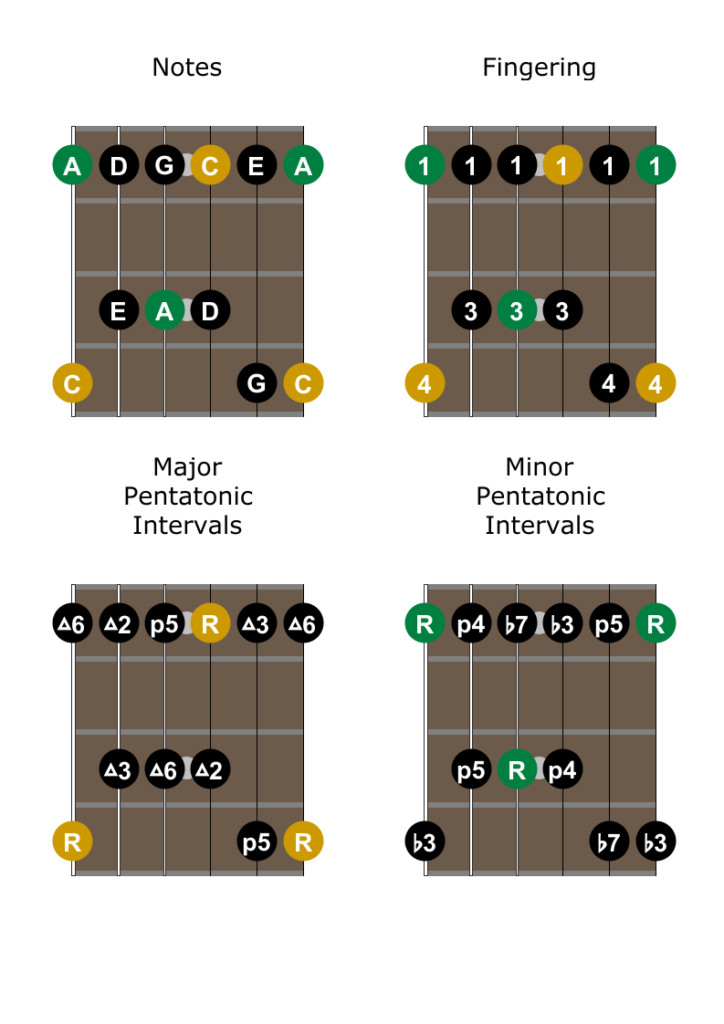 Pentatonic Scale Shape 1
Pentatonic Scale Shape 1
Shape 2: Minor Pentatonic Position 2 / Major Pentatonic Root Position
Shape 2 is the 2nd position of the minor pentatonic scale and the root position of the major pentatonic scale.
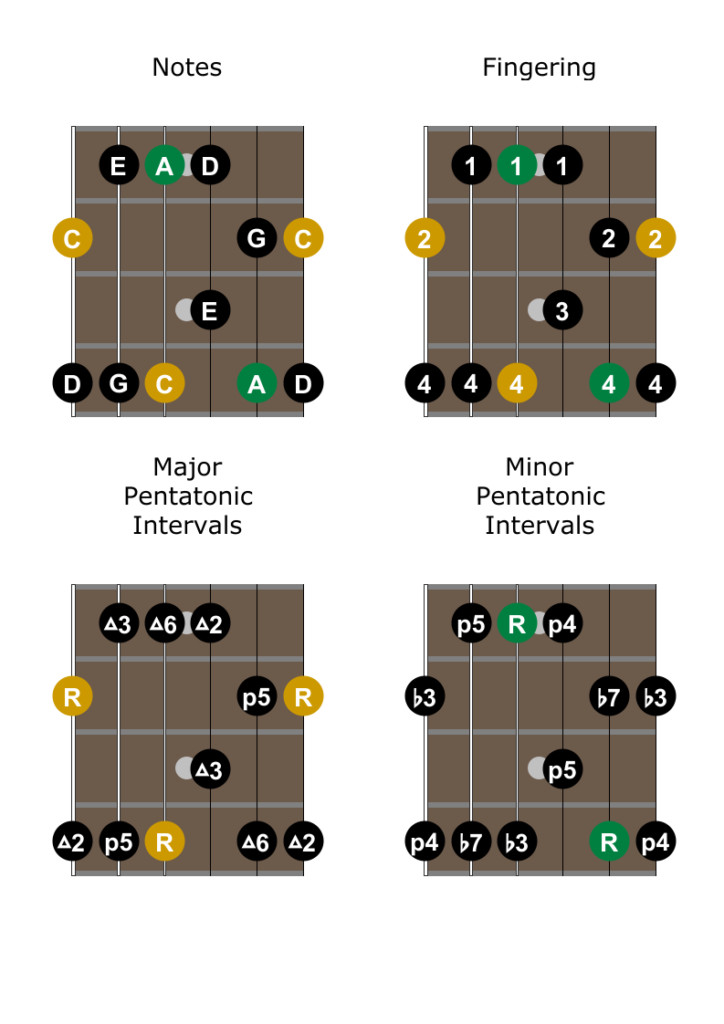 Pentatonic Scale Shape 2
Pentatonic Scale Shape 2
Shape 3: Minor Pentatonic Position 3 / Major Pentatonic Position 2
Shape 3 is the 3rd position of the minor pentatonic scale and the 2nd position of the major pentatonic scale.
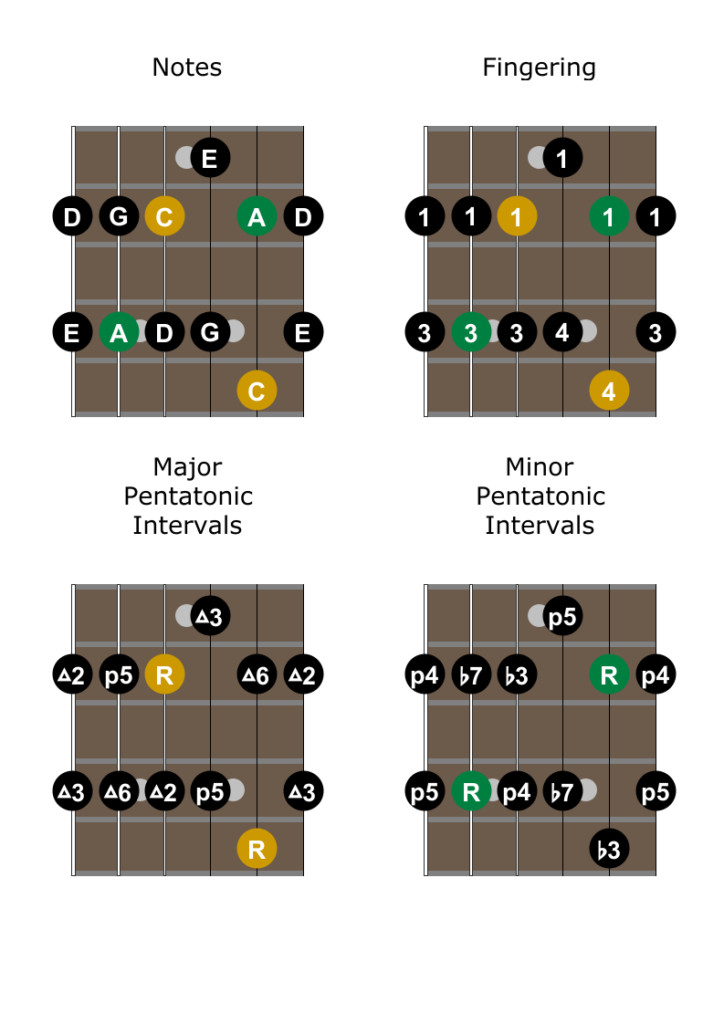 Pentatonic Scale Shape 3
Pentatonic Scale Shape 3
Shape 4: Minor Pentatonic Position 4 / Major Pentatonic Position 3
Shape 4 is the 4th position of the minor pentatonic scale and the 3rd position of the major pentatonic scale.
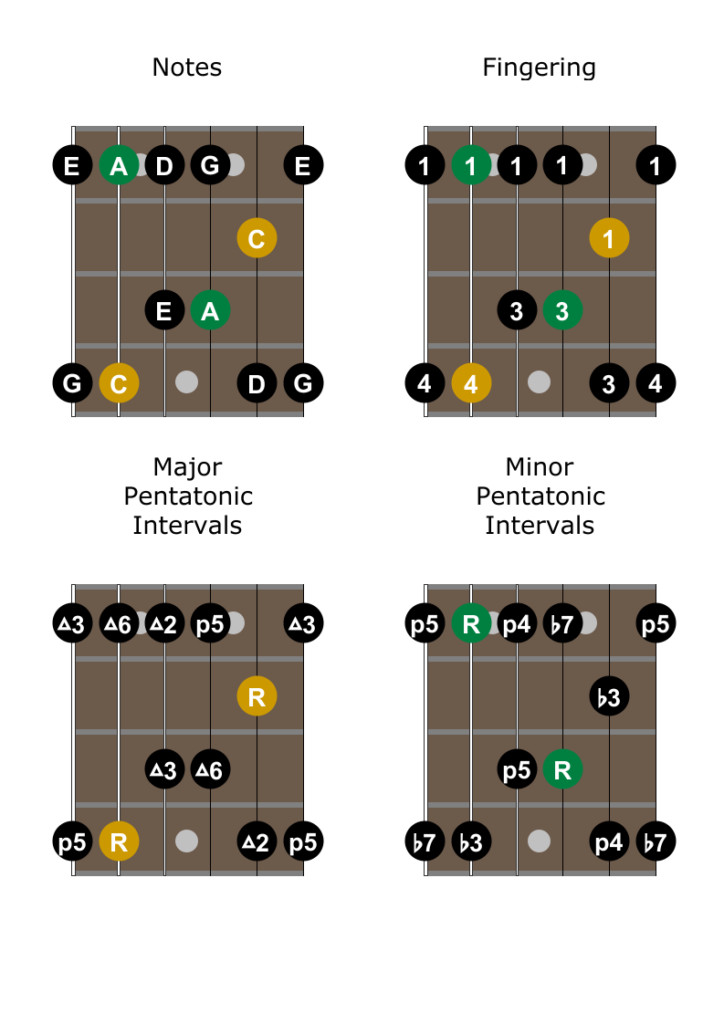 Pentatonic Scale Shape 4
Pentatonic Scale Shape 4
Shape 5: Minor Pentatonic Position 5 / Major Pentatonic Position 4
Shape 5 is the 5th position of the minor pentatonic scale and the 4th position of the major pentatonic scale.
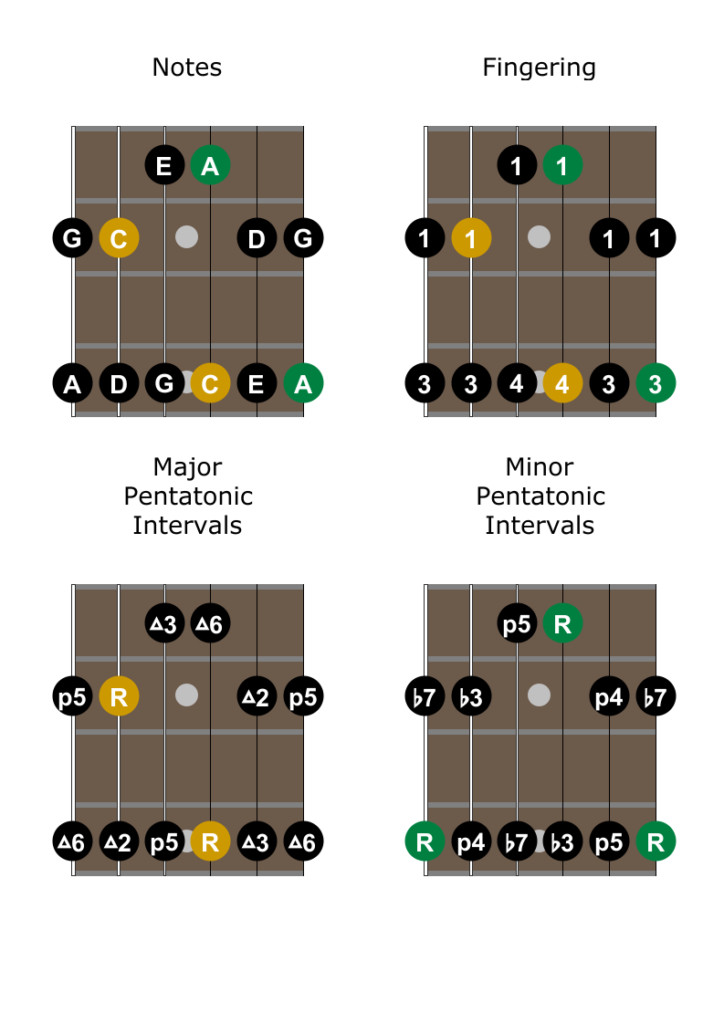 Pentatonic Scale Shape 5
Pentatonic Scale Shape 5
Practice these shapes in different keys, moving them along the fretboard. Use a backing track to improvise and get comfortable with the sound of each shape in a musical context.
Pentatonic Scale Patterns: Beyond Ascending and Descending
Once you know the shapes, the next step is to practice patterns within those shapes. Don’t just go up and down the scale! Patterns will help you internalize the shapes and develop finger dexterity.
Here are a few pattern examples using Shape 1. Remember, these patterns can be applied to all 5 pentatonic shapes.
Pentatonic Scale Pattern 1: String Skipper
e|---------------------------------------------------------5-7-|
B|-----------------------------------------------5-7-8-------|
G|-------------------------------------5-7-7---------------|
D|---------------------------5-7-7-------------------------|
A|-----------------5-7-7-----------------------------------|
E|-5-7-8---------------------------------------------------| Pentatonic Scale Pattern 1 Tab
Pentatonic Scale Pattern 1 Tab
Pentatonic Scale Pattern 2: 3 Note Sequence
(Tab description: Ascending and descending pattern using three notes per string)
Pentatonic Scale Pattern 3: Low Low High High
e|-------------------------------------------------------------|
B|-------------------------------------------------------------|
G|---------------------------------------------------5-7-5-7---|
D|-----------------------------------------5-7-5-7-------------|
A|-------------------------------5-7-5-7-----------------------|
E|-5-7-5-7-----------------------------------------------------| Pentatonic Scale Pattern 3 Tab
Pentatonic Scale Pattern 3 Tab
Pentatonic Scale Pattern 4: Roundabout
(Tab description: Pattern that moves up and down within a localized area of the shape)
Pentatonic Scale Pattern 5: Figure 8
e|-------------------------------------------------------------|
B|-------------------------------------------------5-7-5-------|
G|---------------------------------------5-7-5---------------|
D|-----------------------------5-7-5-------------------------|
A|-------------------5-7-5-----------------------------------|
E|-5-7-5-----------------------------------------------------| Pentatonic Scale Pattern 5 Tab
Pentatonic Scale Pattern 5 Tab
Practice these patterns with a metronome or over a backing track. Experiment with creating your own patterns to explore the shapes in detail.
Pentatonic Scale Licks: Musical Phrases to Inspire You
To make pentatonic scales sound truly musical, you need to learn licks – short, melodic phrases. Here are 5 pentatonic licks, each based on a different pentatonic shape. Lick 1 uses Shape 1, Lick 2 uses Shape 2, and so on.
Pentatonic Scale Lick 1
(Tab description: A short, bluesy lick using bends and slides in Shape 1)
Pentatonic Scale Lick 2
e|-------------------------------------------------------------|
B|-------------------------------------------------------------|
G|-------------------------------------------------------------|
D|-------------------------------------------------------------|
A|-----5-7-5---------------------------------------------------|
E|-5-7-----7-5-------------------------------------------------| Pentatonic Scale Lick 2 Tab
Pentatonic Scale Lick 2 Tab
Pentatonic Scale Lick 3
(Tab description: A faster, more rock-oriented lick in Shape 3 using hammer-ons and pull-offs)
Pentatonic Scale Lick 4
e|-------------------------------------------------------------|
B|-------------------------------------------------------------|
G|-------------------------------------------------------------|
D|-------------------------------------------------------------|
A|-7-5---5-----------------------------------------------------|
E|-----7---7-5-3-----------------------------------------------| Pentatonic Scale Lick 4 Tab
Pentatonic Scale Lick 4 Tab
Pentatonic Scale Lick 5
(Tab description: A melodic lick that moves across strings in Shape 5)
Practice these licks over a backing track to see how they fit musically. Analyze why they sound good and try creating your own licks based on these examples.
Diagonal Pentatonic Scale Shapes: Connecting the Shapes
To truly master the fretboard, you need to connect the 5 pentatonic shapes. Diagonal shapes are created by linking the vertical shapes together, allowing you to move seamlessly across the neck.
Learning diagonal shapes breaks you out of playing in isolated boxes and expands your improvisational possibilities.
Diagonal Pentatonic Scale Shape 1
 Diaganol Pentatonic Scale Shape 1 Diagram
Diaganol Pentatonic Scale Shape 1 Diagram
Diagonal Pentatonic Scale Shape 2
(Diagram description: Diagonal Pentatonic Scale Shape 2 connecting Shape 2 and Shape 3)
Diagonal Pentatonic Scale Shape 3
 Diaganol Pentatonic Scale Shape 3 Diagram
Diaganol Pentatonic Scale Shape 3 Diagram
Diagonal Pentatonic Scale Shape 4
(Diagram description: Diagonal Pentatonic Scale Shape 4 connecting Shape 4 and Shape 5)
Diagonal Pentatonic Scale Shape 5
 Diaganol Pentatonic Scale Shape 5 Diagram
Diaganol Pentatonic Scale Shape 5 Diagram
Practice these diagonal shapes to develop a wider perspective of the pentatonic scale and improve your fretboard navigation.
Improvising with the Pentatonic Scale: Putting it All Together
Now for the fun part: using the pentatonic scale to improvise!
Pentatonic Scales Over Chord Progressions
Let’s look at how pentatonic scales work over chords. In the key of C major, you have diatonic chords. Interestingly, the C major scale contains the notes of several pentatonic scales:
- C Major (A minor) Pentatonic: C D E G A
- F Major (D minor) Pentatonic: F G A C D
- G Major (E minor) Pentatonic: G A B D E
This means you can use C major, F major, or G major pentatonic scales when improvising over a chord progression in C major. Each will have a slightly different flavor, but the pentatonic scale built from the root of the key (C major pentatonic in the key of C) usually works best as a starting point.
Here’s a breakdown of chord types in a major key and the corresponding pentatonic scales:
- I, IV, and V chords (major chords) – Use the major pentatonic scale built from the root of the chord.
- ii, iii, and vi chords (minor chords) – Use the minor pentatonic scale built from the root of the chord.
For a vi IV I V progression in C major (Am F C G), you could try:
- C major (A minor) pentatonic scale over the entire progression. This provides a general, key-center sound.
- Switch pentatonic scales with each chord: A minor pentatonic over Am, F major pentatonic over F, C major pentatonic over C, and G major pentatonic over G. This creates a more chord-specific and harmonically rich improvisation.
Pentatonic scales also include chord extensions, adding even more color:
- Major pentatonic: includes the 9th and 6th in addition to the major triad (root, 3rd, 5th).
- Minor pentatonic: includes the b7th and 11th in addition to the minor triad (root, b3rd, 5th).
These extensions let you bring out the unique qualities of each chord in your improvisation.
Pentatonic Scales and the Blues
The pentatonic scale is a cornerstone of blues improvisation. The standard 12-bar blues progression uses three chords: I7, IV7, V7.
In A blues, this is A7 (I7), D7 (IV7), and E7 (V7).
 12 Bar Blues in A
12 Bar Blues in A
For a bluesy sound over a 12-bar blues in A, use the A minor pentatonic scale. The “minor over major” sound (minor scale over major chords) is characteristic of the blues. Dominant 7th chords are essentially major triads with a b7th, so the minor pentatonic scale creates that classic blues tension.
You can also experiment with the A major pentatonic scale over a blues progression for a different, perhaps more upbeat or major-key blues feel.
Pentatonic Scale and the Blues Scale: Adding the Blue Note
The blues scale is very closely related to the pentatonic scale. It’s simply a pentatonic scale with one extra note – the “blue note.”
For the A blues scale, it’s the A minor pentatonic scale with the b5th added. This blue note (b5th of the minor pentatonic scale, or b3rd of the major pentatonic scale) is what gives the blues scale its signature sound.
Here are the shapes for the blues scale on guitar:
Blues Scale Shape 1
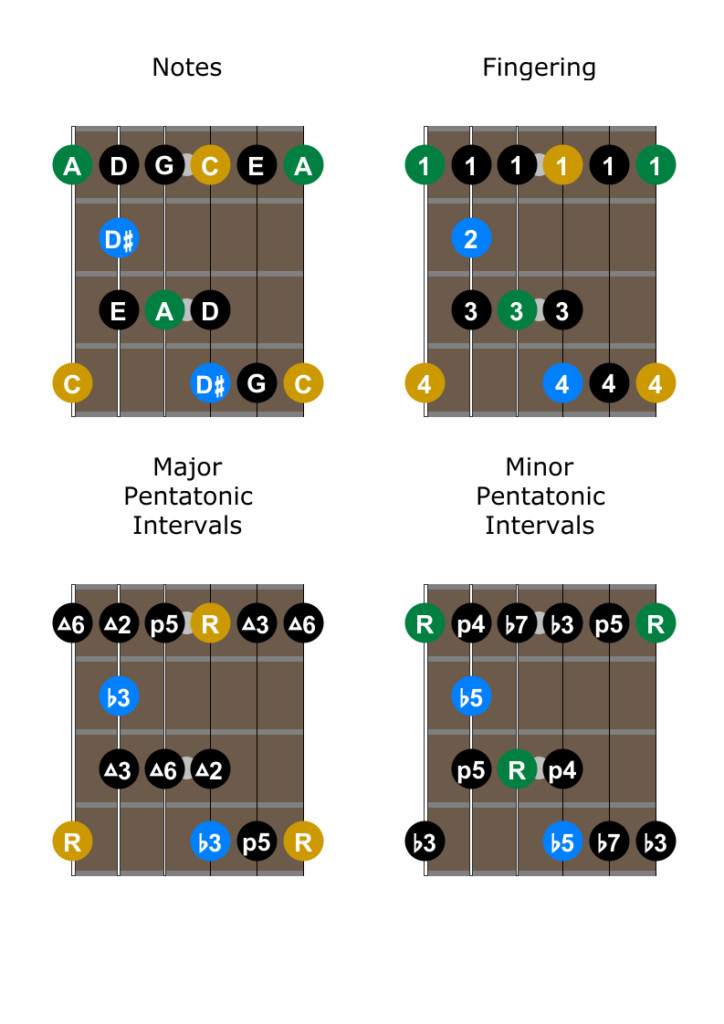 Blues Scale Shape 1
Blues Scale Shape 1
Diagram of Blues Scale Shape 1, showing the added blue note.
Blues Scale Shape 2
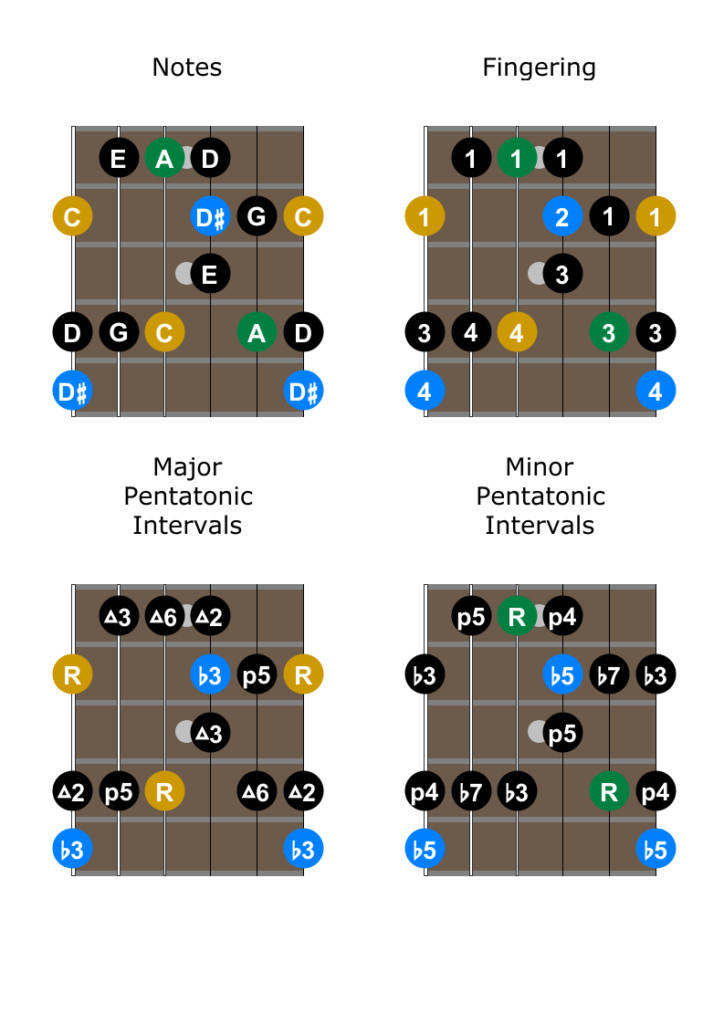 Blues Scale Shape 2
Blues Scale Shape 2
Diagram of Blues Scale Shape 2, showing the added blue note.
Blues Scale Shape 3
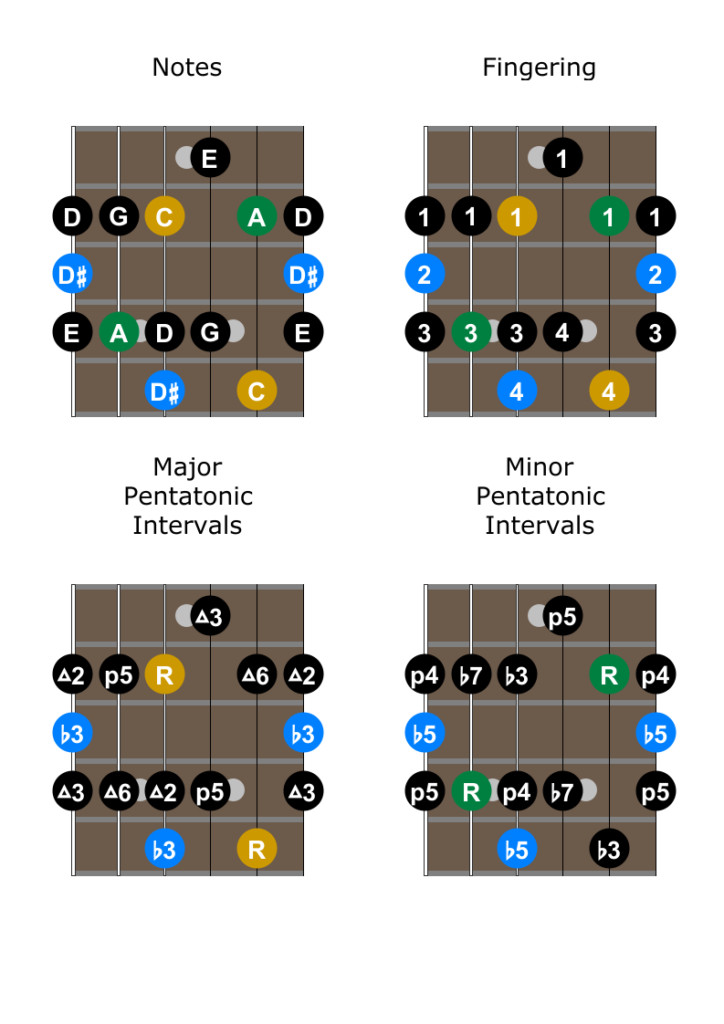 Blues Scale Shape 3
Blues Scale Shape 3
Diagram of Blues Scale Shape 3, showing the added blue note.
Blues Scale Shape 4
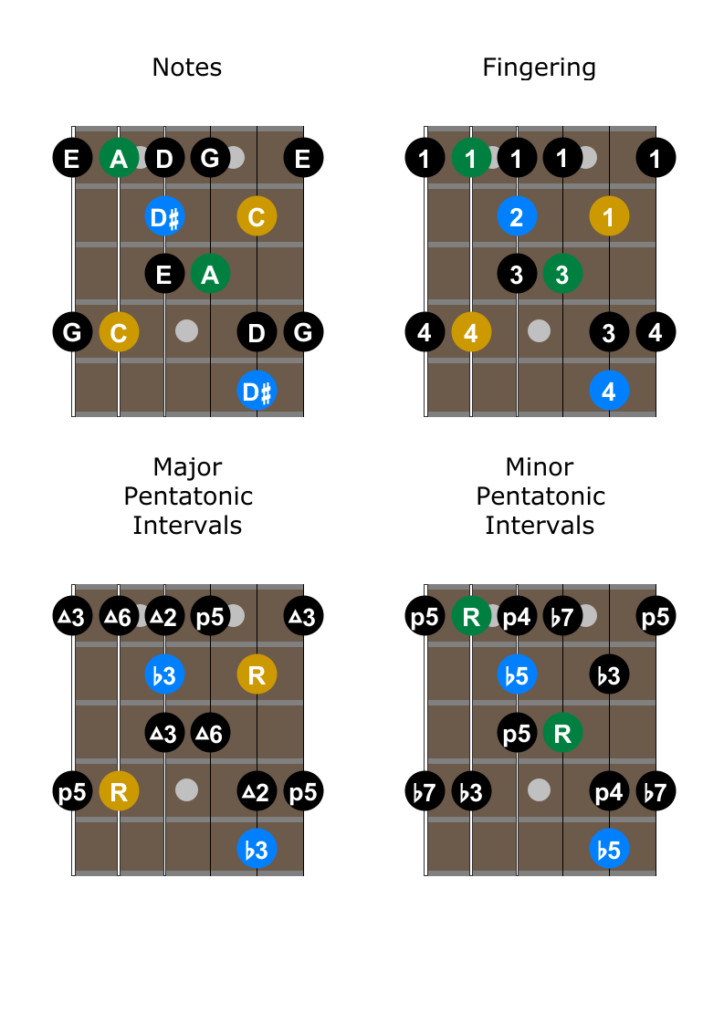 Blues Scale Shape 4
Blues Scale Shape 4
Diagram of Blues Scale Shape 4, showing the added blue note.
Blues Scale Shape 5
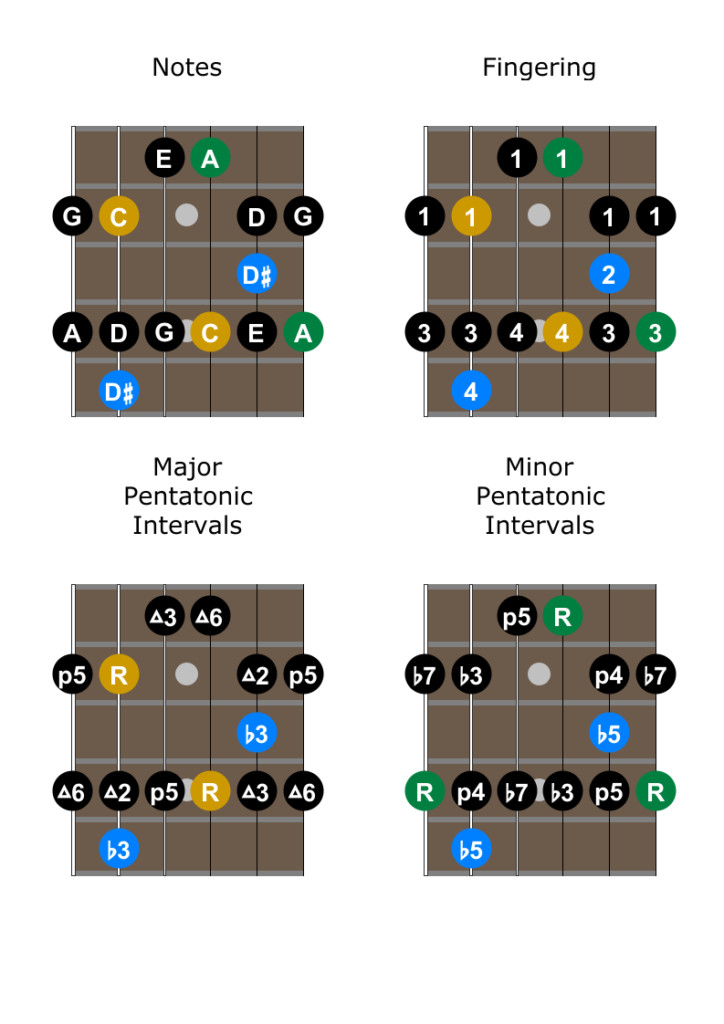 Blues Scale Shape 5
Blues Scale Shape 5
Practice the blues scale shapes over a 12-bar blues backing track to incorporate that essential bluesy flavor into your playing.
Pentatonic Scales and Movable Chord Shapes: Chords Within Scales
Both major and minor pentatonic scales contain all the notes of their respective major and minor triads. This means you can find movable chord shapes within each pentatonic scale shape!
Playing the chord shape followed by the surrounding scale helps you understand how the chord and scale relate to each other.
Pentatonic Scale Shape 1 Chords
Major Chord Tones
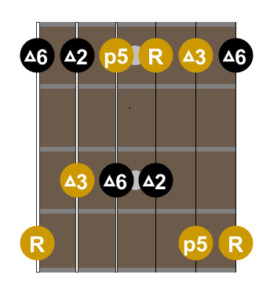 Shape 1 Major Chord Tones
Shape 1 Major Chord Tones
Minor Chord Tones
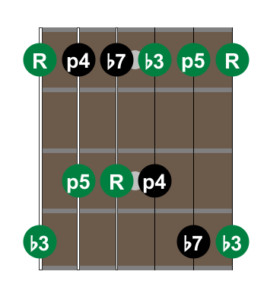 Shape 1 Minor Chord Tones
Shape 1 Minor Chord Tones
Movable Major Chord Fingering
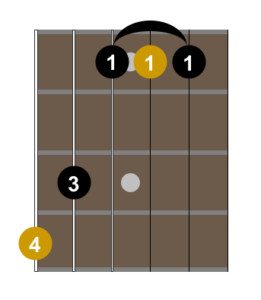 Shape 1 Movable Major Chord
Shape 1 Movable Major Chord
Movable Minor Chord Fingering
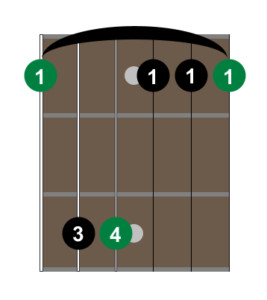 Shape 1 Movable Minor Chord
Shape 1 Movable Minor Chord
Pentatonic Scale Shape 2 Chords
Major Chord Tones
 Shape 2 Major Chord Tones
Shape 2 Major Chord Tones
Minor Chord Tones
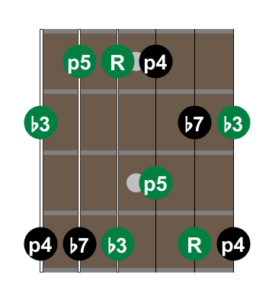 Shape 2 Minor Chord Tones
Shape 2 Minor Chord Tones
Movable Major Chord
 Shape 2 Movable Major Chord
Shape 2 Movable Major Chord
Movable Minor Chord
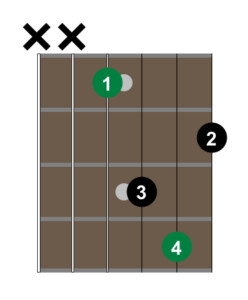 Shape 2 Movable Minor Chord
Shape 2 Movable Minor Chord
Pentatonic Scale Shape 3 Chords
Major Chord Tones
Diagram showing Major Chord Tones within Pentatonic Scale Shape 3.
Minor Chord Tones
 Shape 3 Minor Chord Tones
Shape 3 Minor Chord Tones
Movable Major Shape
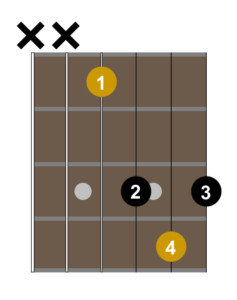 Shape 3 Movable Major Chord
Shape 3 Movable Major Chord
Movable Minor Shape
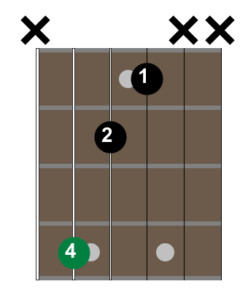 Pentatonic Scale Shape 3 Movable Minor Chord
Pentatonic Scale Shape 3 Movable Minor Chord
Pentatonic Scale Shape 4 Chords
Major Chord Tones
 Shape 4 Major Chord Tones
Shape 4 Major Chord Tones
Minor Chord Tones
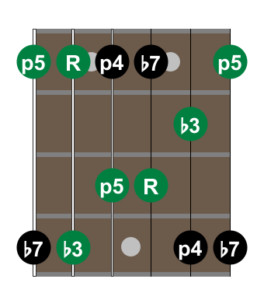 Shape 4 Minor Chord Tones
Shape 4 Minor Chord Tones
Movable Major Chord
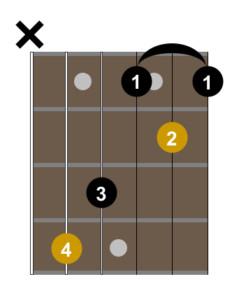 Shape 4 Movable Major Chord
Shape 4 Movable Major Chord
Movable Minor Chord
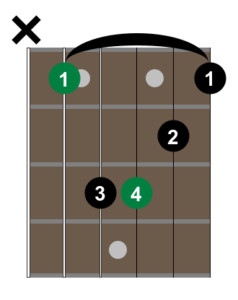 Shape 4 Movable Minor Chord
Shape 4 Movable Minor Chord
Pentatonic Scale Shape 5 Chords
Major Chord Tones
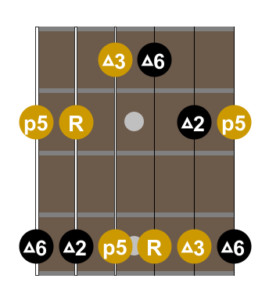 Shape 5 Major Chord Tones
Shape 5 Major Chord Tones
Minor Chord Tones
 Shape 5 Minor Chord Tones
Shape 5 Minor Chord Tones
Movable Major Chord
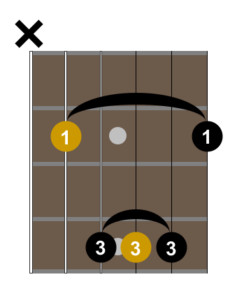 Shape 5 Movable Major Chord
Shape 5 Movable Major Chord
Movable Minor Shape
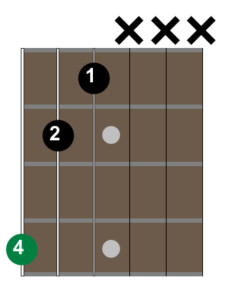 Pentatonic Scale Shape 5 Movable Minor Chord
Pentatonic Scale Shape 5 Movable Minor Chord
Learning these chord shapes within the pentatonic scales enhances your understanding of harmony and allows you to seamlessly switch between chords and lead lines.
The Major-Minor Pentatonic Scale: Combining Major and Minor
In some musical situations, you might want to use both major and minor pentatonic scales over the same root. This creates a “major-minor” sound, blending elements of both tonalities.
By combining the shapes of the major and minor pentatonic scales with the same root, you get the major-minor pentatonic scale.
Major-Minor Pentatonic Scale Shape 1
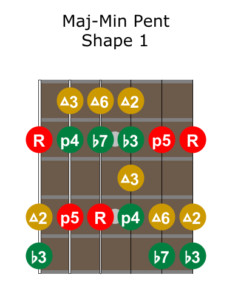 Major-Minor Pentatonic Scale Shape 1
Major-Minor Pentatonic Scale Shape 1
Diagram of Major-Minor Pentatonic Scale Shape 1, showing combined major (yellow) and minor (green) notes.
Major-Minor Pentatonic Scale Shape 2
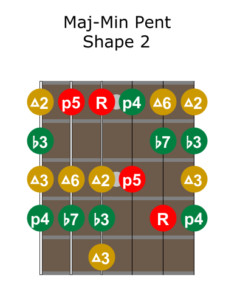 Major-Minor Pentatonic Scale Shape 2
Major-Minor Pentatonic Scale Shape 2
Diagram of Major-Minor Pentatonic Scale Shape 2, showing combined major (yellow) and minor (green) notes.
Major-Minor Pentatonic Scale Shape 3
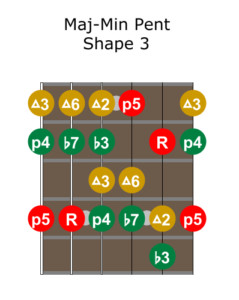 Major-Minor Pentatonic Scale Shape 3
Major-Minor Pentatonic Scale Shape 3
Diagram of Major-Minor Pentatonic Scale Shape 3, showing combined major (yellow) and minor (green) notes.
Major-Minor Pentatonic Scale Shape 4
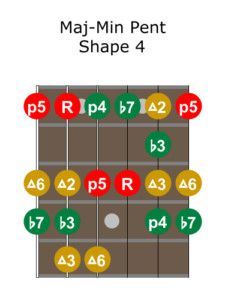 Major-Minor Pentatonic Scale Shape 4
Major-Minor Pentatonic Scale Shape 4
Diagram of Major-Minor Pentatonic Scale Shape 4, showing combined major (yellow) and minor (green) notes.
Major-Minor Pentatonic Scale Shape 5
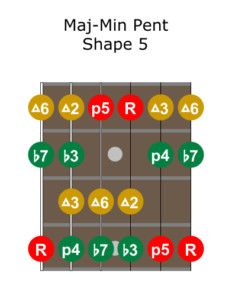 Major-Minor Pentatonic Scale Shape 5
Major-Minor Pentatonic Scale Shape 5
Diagram of Major-Minor Pentatonic Scale Shape 5, showing combined major (yellow) and minor (green) notes.
Experiment with the major-minor pentatonic scale to add a unique flavor to your improvisations and compositions.
Conclusion: Unleash Your Pentatonic Power!
This guide has provided you with a comprehensive introduction to the pentatonic scale, complete with pentatonic scale guitar tabs, shapes, patterns, and musical applications. You now have the tools to craft killer riffs, write captivating solos, and explore a vast landscape of musical ideas.
While there are many other scales to learn, the pentatonic scale is an essential starting point for any guitarist seeking to improvise, write melodies, and create music in a wide range of styles.
So, grab your guitar, practice these shapes and patterns, and start jamming! The world of the pentatonic scale is waiting for you to explore it.
